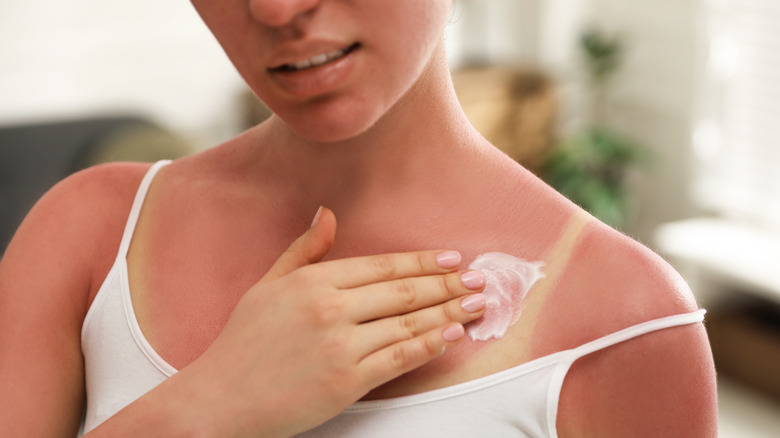What Happens To Your Body When You Get Sunburned More Than Five Times
Each day you step outside, your skin is exposed to the sun's rays. It's one thing if you're sporting a tank top and shorts to get the morning paper, but you'll probably need to slather on the SPF 15 if you plan to take a walk. You never know if your short walk will become a longer one, particularly if you run into someone you know.
On a day when the UV Index is 7 or higher, your skin can burn in as little as 15 minutes if you're not wearing any sun protection, according to the Arizona Department of Health Services. Even if you don't see the red skin from sunburn, your body is still absorbing radiation from the sun, according to Healthline. This radiation damages the DNA in your skin's cells. Add up those few minutes of sun exposure over several years and you could see some serious damage to your skin. If you've been sunburned more than five times in your younger years, you double your risk of melanoma, according to the Skin Cancer Foundation.
Sunburns and melanoma
The Skin Cancer Foundation says that skin cancer is the most common cancer in the United States, with two people dying from this form of cancer every hour. Although cases of melanoma are expected to decline, deaths from melanoma are anticipated to rise. That's because invasive melanoma, which permeates the skin's middle layer, has been increasing.
Sunburns are pretty common when you're younger, with more than 75% of children getting sunburned every year. Yet we don't learn much as we get older, with half of adults under 30 reporting a sunburn in a year (via Cleveland Clinic). Getting frequent sunburns when you were younger increases your risk of melanoma, because more of the sun's radiation has penetrated your skin. Even a bad, second-degree sunburn with blisters in childhood can more than double your risk of melanoma, according to the Skin Cancer Foundation. Second-degree sunburns damage the middle layer of your skin.
Risks of sunburn
People with lighter skin and hair are more at risk for sunburn. These individuals should be more vigilant in protecting themselves from the sun's harmful rays. People who live at higher altitudes and in latitudes closer to the equator are also more prone to UV radiation. People who participate in outdoor sports and recreation activities such as running, fishing, or swimming will need to protect themselves from long bouts in the sun. A 2023 article in Cancers found that swimmers, surfers, and marathon runners are more likely to develop melanoma.
Sunburn not only increases your risk for skin cancers, but the sun also contributes to premature aging of your skin, leading to sagging and wrinkles. Sun exposure also can lead to eye damage or cataracts.
To protect yourself from sunburn, slather any exposed skin with SPF 15 when you walk outside, and reapply after sweating and swimming. These days, you can find clothing that can protect your skin from the sun's damaging rays. If possible, seek shade when you can under an umbrella or a tree. Still going to tanning beds? You'll need to give those up to protect your skin.



